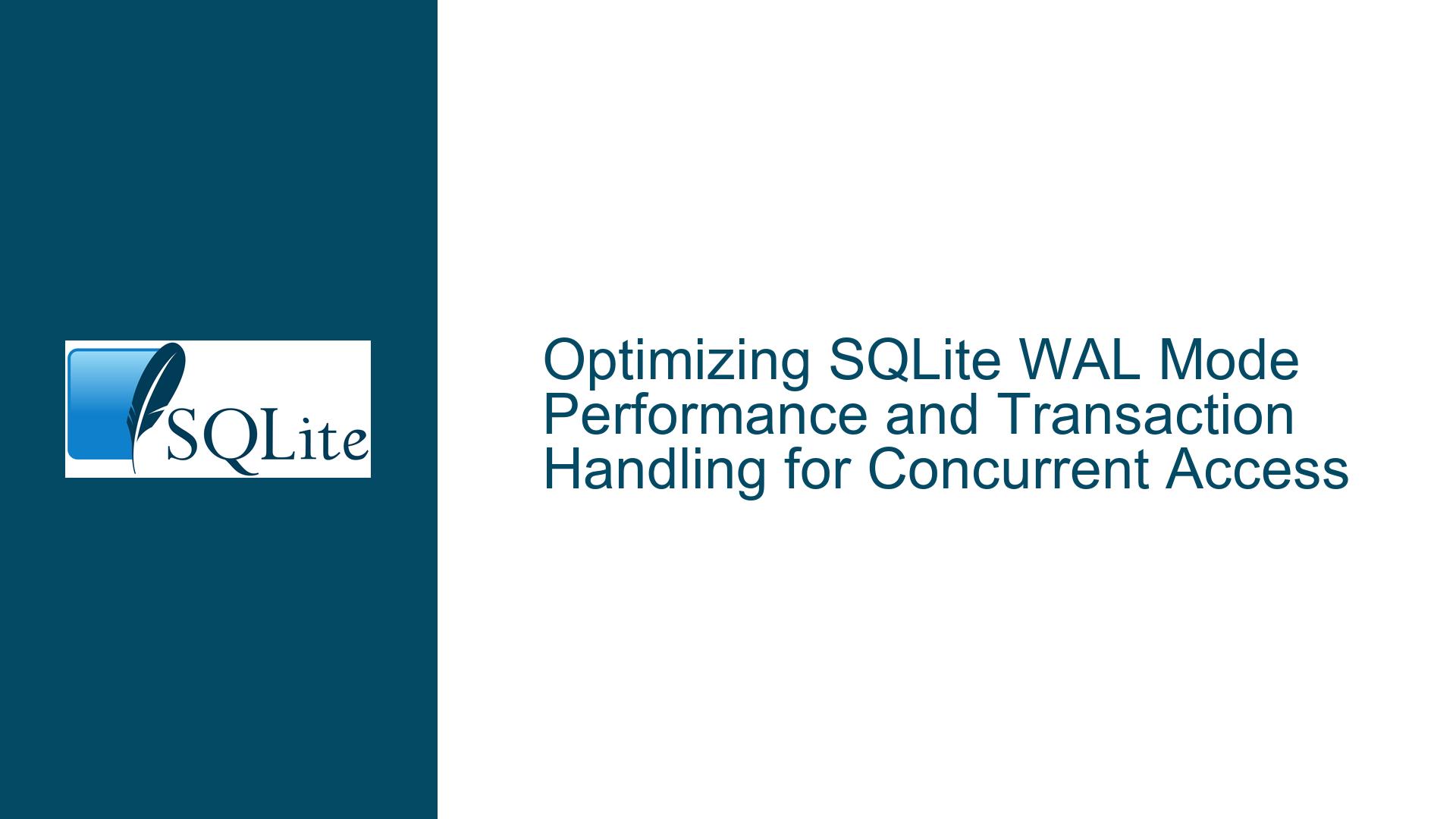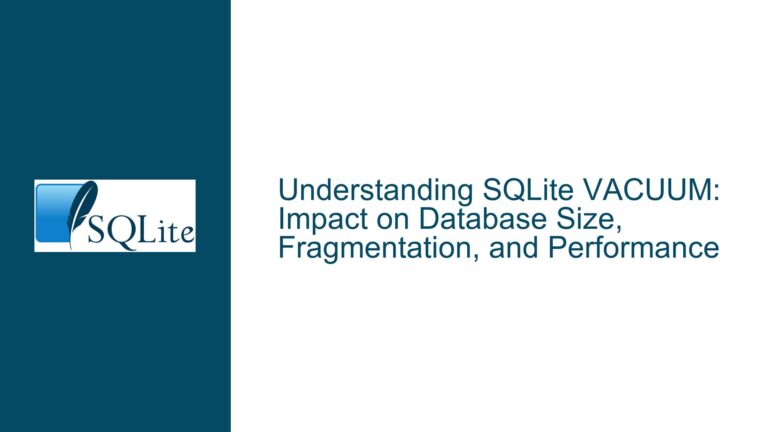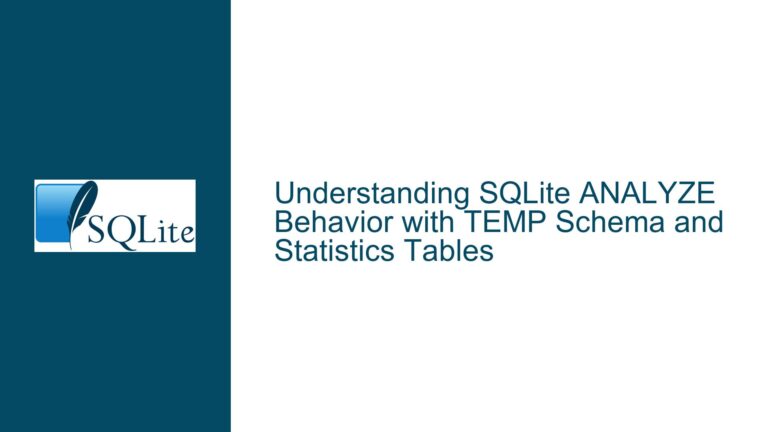Optimizing SQLite WAL Mode Performance and Transaction Handling for Concurrent Access
Understanding SQLite WAL Mode Tradeoffs and Transaction Strategies for High-Concurrency Workloads
Transaction Isolation Mechanics and Journal Mode Fundamentals
The core challenge revolves around balancing concurrent read/write access with performance stability in SQLite deployments. Journal modes (WAL vs DELETE) fundamentally alter how SQLite implements atomic commits and isolation guarantees. In DELETE mode (default rollback journal), writers acquire RESERVED locks during transactions and EXCLUSIVE locks during commit phases. This creates contention where readers must wait for pending writes to complete. WAL mode inverts this architecture by allowing readers to access the last-committed database state via separate WAL files while writers append changes to the WAL. This enables true read/write concurrency but introduces checkpointing mechanics where WAL content periodically merges into the main database file.
Performance discrepancies arise from how applications structure transactions and interact with these architectures. Bulk insertion throughput in WAL mode heavily depends on checkpoint frequency, transaction batching granularity, and synchronous durability settings. The EXCLUSIVE transaction keyword in SQLite forces acquisition of an exclusive lock immediately rather than progressing through RESERVED/PENDING states. While this blocks readers in DELETE mode, it has different implications in WAL mode where readers operate from the shared WAL state. Application crashes risk database corruption when durability safeguards like synchronous=full are disabled, requiring careful calibration between crash safety and write speed.
Concurrency Contention and Checkpoint Pressure in WAL Deployments
The observed performance degradation in WAL mode versus DELETE mode stems from hidden coordination costs and resource contention patterns. When a Python script executes individual INSERT statements without explicit transaction boundaries, SQLite defaults to autocommit mode – each statement runs in its own micro-transaction. In DELETE mode, this forces repeated journal file flushes but avoids prolonged lock retention. WAL mode accumulates these micro-transactions in the write-ahead log without immediate merging to the main database. However, the WAL file grows until checkpointing occurs, which can trigger expensive I/O operations if the autocheckpoint threshold (default 1000 pages) is reached during bulk writes.
Checkpoint starvation emerges when writer threads generate WAL content faster than the background checkpoint process can integrate changes into the main database. This manifests as sudden latency spikes during sustained write workloads. Concurrent reader threads in WAL mode exacerbate this by maintaining open read transactions that prevent checkpoint truncation – a phenomenon called "reader-induced checkpoint blocking". The EXCLUSIVE transaction hint in WAL mode attempts to force immediate checkpoint completion but often degrades throughput by serializing writer access.
SYNCHRONOUS=OFF introduces risk by allowing the OS to buffer disk writes without verification. While this accelerates INSERT operations, it creates vulnerability windows where application crashes could corrupt the WAL state. DELETE mode with SYNCHRONOUS=NORMAL provides partial durability with fewer fsync operations compared to WAL’s default synchronous=FULL. However, WAL’s append-only design still offers superior crash recovery in many scenarios despite raw throughput differences.
Tuning WAL Checkpoint Behavior and Transactional Batching
Step 1: Analyze Transaction Scope and Checkpoint Triggers
Enable SQLite’s PRAGMA wal_checkpoint(TRACE); before bulk write operations to monitor automatic checkpoint activity. High-frequency checkpointing during write batches indicates suboptimal transaction sizing. Wrap bulk inserts in explicit BEGIN…COMMIT blocks to minimize autocommit overhead. For Python’s executemany(), combine with manual transaction control:
with connection:
cursor.executemany("INSERT INTO t1 VALUES (?,?,?)", data_chunk)
This ensures all inserts in data_chunk execute within a single transaction. Monitor the WAL size via PRAGMA wal_checkpoint(TRACE); after each batch to identify checkpoint thresholds being triggered prematurely.
Step 2: Calibrate Checkpoint Frequency and Batch Sizes
Set PRAGMA wal_autocheckpoint=N; to control how often SQLite attempts automatic checkpoints. For bulk loads exceeding 100k rows, disable autocheckpoint (PRAGMA wal_autocheckpoint=0;) and manually invoke PRAGMA wal_checkpoint(RESTART); after full dataset ingestion. Balance batch sizes against available memory – 100-row batches work well for narrow tables (5 columns), while 500-1000 row batches optimize wider datasets. Test with:
batch_size = 100
for i in range(0, len(full_data), batch_size):
with connection:
cursor.executemany("INSERT...", full_data[i:i+batch_size])
# Optional manual checkpoint every 10 batches
if i % (batch_size*10) == 0:
cursor.execute("PRAGMA wal_checkpoint(PASSIVE);")
Step 3: Optimize Synchronous and Journal Mode Configuration
For crash-protected writes without full durability guarantees, use:
PRAGMA synchronous=NORMAL;
PRAGMA journal_mode=WAL;
PRAGMA journal_size_limit=104857600; -- 100MB WAL cap
This configuration allows the OS to group writes while maintaining WAL integrity across application crashes. Avoid SYNCHRONOUS=OFF except for ephemeral data. When using DELETE mode with high concurrency, pair EXCLUSIVE transactions with write-timeout retries:
max_retries = 3
for attempt in range(max_retries):
try:
with connection:
cursor.execute("BEGIN EXCLUSIVE")
# Perform writes
cursor.execute("COMMIT")
break
except sqlite3.OperationalError as e:
if 'locked' in str(e) and attempt < max_retries-1:
sleep(0.1)
else:
raise
Step 4: Monitor and Mitigate Reader-Induced Checkpoint Blocking
Long-running read transactions prevent WAL checkpoint completion, causing file growth. Instrument reader code with:
PRAGMA busy_timeout=2000; -- Retry on contention
BEGIN TRANSACTION READONLY;
-- Read operations
COMMIT;
Avoid holding read transactions across application logic boundaries. For dashboard-style queries that require consistent snapshots, attach a separate database in WAL mode for analytical queries using ATTACH DATABASE 'readonly_copy' AS ro; maintained via periodic SQLite backup API calls.
Step 5: Benchmark and Compare WAL vs DELETE Mode Under Load
Construct a performance test harness that mirrors production access patterns:
import sqlite3, timeit
def test_wal():
conn = sqlite3.connect('test.db')
conn.execute("PRAGMA journal_mode=WAL")
conn.execute("PRAGMA synchronous=NORMAL")
# Insert 50,000 rows in 500-row batches
for _ in range(100):
with conn:
conn.executemany("INSERT...", data_500_rows)
def test_delete():
conn = sqlite3.connect('test.db')
conn.execute("PRAGMA journal_mode=DELETE")
conn.execute("PRAGMA synchronous=FULL")
# Same insert pattern
...
print("WAL:", timeit.timeit(test_wal, number=10))
print("DELETE:", timeit.timeit(test_delete, number=10))
Analyze results across SSD vs HDD storage, mixed read/write workloads, and varying batch sizes. Expect WAL to outperform DELETE mode in concurrent access scenarios but potentially lag in write-only bulk loads without proper checkpoint tuning.
Step 6: Implement Application-Level Crash Recovery
When using SYNCHRONOUS=OFF or NORMAL, augment SQLite’s built-in recovery with:
- Write-ahead logging to application-specific transaction journals
- Periodic full database backups via
sqlite3_backup_init() - Checksum validation of critical tables during startup
- WAL file size monitoring with automatic checkpoint triggering
For Python deployments:
import hashlib
def verify_table_integrity(conn, table):
# Simple row count + hash audit
cursor = conn.execute(f"SELECT COUNT(*), SUM(hash) FROM {table}")
count, total_hash = cursor.fetchone()
expected = load_from_application_log()
return count == expected['count'] and total_hash == expected['hash']
def crash_recovery():
conn = sqlite3.connect('app.db')
conn.execute("PRAGMA integrity_check")
if not verify_table_integrity(conn, 'transactions'):
restore_from_backup()
Step 7: Diagnose and Resolve EXCLUSIVE Transaction Contention
Use SQLite’s sqlite3_stmt_status() interface to monitor transaction lock acquisition latency. In WAL mode, EXCLUSIVE transactions force a full checkpoint and block new readers until completion. Replace blanket EXCLUSIVE usage with:
- IMMEDIATE transactions for write priority without full exclusivity
- Retry loops with exponential backoff on OperationalError: database is locked
- Queue-based write serialization using Python’s
queuemodule
For critical writes requiring atomic visibility:
with connection:
# WAL mode automatically provides atomic commit visibility
cursor.execute("BEGIN IMMEDIATE")
cursor.execute("...")
cursor.execute("COMMIT")
Step 8: Profile and Optimize Filesystem Interaction
SQLite performance heavily depends on underlying storage characteristics. For WAL mode:
- Place database and WAL files on the same filesystem mount
- Preallocate WAL space using
PRAGMA journal_size_limit=... - Mount filesystems with
noatime,nobarrieroptions (Linux) - Test with different page sizes (
PRAGMA page_size=4096;) - Monitor I/O wait times during checkpoint operations
Use Linux iotop and blktrace to identify storage layer bottlenecks. Consider RAM disks for transient databases or enabling SQLite’s memsharing (SQLITE_OPEN_MEMORY).
Step 9: Upgrade and Patch SQLite Engines
Older SQLite versions contain WAL mode optimizations and bug fixes. For Python environments:
# Install latest pysqlite3 with modern SQLite
pip install pysqlite3-binary
Verify version compatibility:
import sqlite3
print(sqlite3.sqlite_version) # Target >=3.38.0 for WAL improvements
Step 10: Implement Comprehensive Monitoring
Deploy telemetry capturing:
- WAL file size over time
- Checkpoint completion latency
- Transaction lock wait durations
- Page fault rates during queries
- Cache hit/miss ratios (
PRAGMA cache_stats;)
Integrate with application metrics dashboards to correlate SQLite behavior with business logic performance. Set alerts for WAL file exceeding size thresholds or checkpoint durations surpassing SLA limits.
By systematically applying these diagnostics and optimizations, developers can achieve sub-millisecond write latencies in WAL mode while maintaining strong consistency guarantees and crash resilience. The key lies in aligning transaction boundaries with data access patterns, carefully calibrating durability versus speed tradeoffs, and proactively managing WAL’s checkpoint lifecycle.





